|

Bunad - Traditional Norwegian Dress


A bunad is a traditional Norwegian costume, typically of rural origin. Bunads are local to Norway´s traditional districts, and the result both of traditional evolution and organized efforts to discover and modernize traditional designs.
There are bunads both for men and women, though women´s bunads are more diverse and popular. The women´s dresses are elaborately embroidered in beautiful colors in wool thread on dark wool garments. The patterns have great significance and it takes a good hand and eye to make. There are also shawls, scarves, and different head gear as well as silver or gold jewelry, often hand-made.
The Hallingdal bunad, black wool with reds/yellows/golds/purples/greens, requires about 300 hours of embroidery for each one, and it weighs about 13 lbs. when finished.

In Norway it is common to wear bunad as a costume at various celebrations, such as the May 17 National Day celebration. Its use has reached far outside folk dancing and folk music. Even at official formal arrangements you will see people in bunads, especially women. It is difficult to say how many different types of bunads in Norway, there may be around 200.
The various bunads have their own distinct origin. Some of them are based on old local customs, other models are reconstructions made in the 20th century, relying on local and historical material. The interest for bunads started with the folk dance movement at the beginning of the 20th century
In folk costume research one differentiates between bunad and folk costume. "Folk costume" being the local dress in previous times with all its variations and use. Bunads are used for festive occasions and today they date back to the folk costume tradition of the 19th century.
In some parts of the country folk costume tradition was alive well into the 19th century. Bunads with such long traditions are to be found in the Bergen area on the west coast, in Setesdal in the south, in some districts of Telemark, Numedal, Hallingdal, Gudbrandsdalen and at Røros in eastern Norway.
Anderson, Sonna & Lutness, Vi

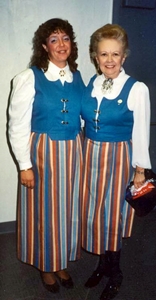
Twin Hvardag´s bunader
Benson, Bernice

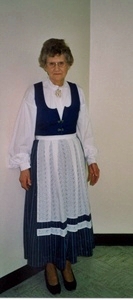
Hvardag´s Bunad
Benz, Louise

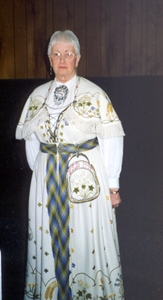
This bunad was made by Louise.
Blaich, Hilma

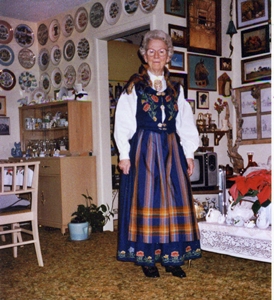
Both of her parents came from Vintinfjord in Nordland so she chose that bunad. The material was embroidered there and sent to Barronett, Wisconson where they sewed it together for Hilma. It was sent to Hilma and all she had to do was tie the fringe on the scarf. She has enjoyed wearing it and her husband, Ernest, was so proud of her when she wore it. He bought the jewelry for Hilma.
Botnen, Margaret

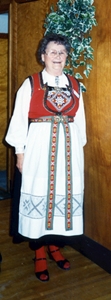
Margaret's Hardanger bunad was made in Norway by three of her husband Erling's cousins. The pleated skirt is virgin wool. The blouse has a typical drop sleeve. All decorations are of Hardanger embroidery. The apron has an insert of Hardanger embroidery as well. The belt is handwoven and the breast plate is handmade. All of the jewelry was bought from a silversmith from Setersdalen.
Christianson, Candace

Candace Christianson’s bunad is from Hemsedal in the Hallingdal area of Buskerud, Norway, where her great grandmother lived before immigrating to America. The bunad was made by Husfliden Hallingdal AS in Gol, Norway in 2012.
The bodice is made of black cloth with wool embroidery in various colors with an emphasis on red.
The pleated skirt is made of a wool damask material, with embroidery around the hem. The embroidery is made of wool yarn in a variety of colors.
The blouse is made of white linen and whitework embroidery at the collar and cuffs of the sleeves.
Fine wool is used for the apron which has a printed rose pattern on a black background.
The matching hat features colorful embroidery.
The bunad silver consists of button cufflinks, a small and large brooch for the blouse and two silver buckles with a chain for the bodice.
Vestfold - Berit Eggers received her bunad (the one displayed on the maniquin) as a gift from her mother in 1975. The blouse is linen, with embroidered neckband and cuffs. The vest is red and is lined and has stays to hold it in shape.
The skirt is blue, pleated, and the waistline is high. The belt and the border on the skirt is woven, it has a pocket purse. It has a cotton petticoat with a pocket in front.
The apron is striped wool, with pom-poms on the ties. Red stockings and black bunad shoes with buckles are used with this bunad. The pin is unusual - it is silver and was inherited from her mother. The cape has silver clasps.
The bunad in the center and the right side is from Ost Telemark. Berit purchased the bunad at the Norsk Høstfest, and had it tailored for her in Norway. The bunad has a red jacket that is featured on the picture to the right.
Picture to the left is of Janet in her Hardanger bunad.
The center picture and picture to the right are of Janet in the bunad she inherited from her Aunt Valborg Fisher. It is a Vest Agder Bunad, which comes from the southern most tip of Norway. This bunad style dates from 1830. This bunad is made of black wool with Rosemaling embroidered on the apron, shawl and purse. The skirt is held in place by hand woven suspenders. The blouse is linen and features embroidery on the collar, cuffs, and shoulders. The Solje (or silver) is the authentic jewelry for this bunad.
A damask cap or white head scarf may be worn.
The purse must be half hidden by the apron.
Black shoes and stockings are needed.
This bunad was made in the Norsk Husfliden in Mandal, Norway.
Evenson, Donna

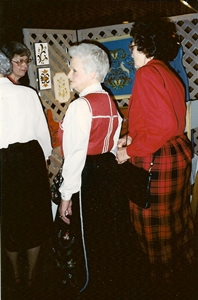
Donna Evenson's Rogaland bunad is typical of the area around Stavanger, Norway.
Very little is known of this early bunad, but in 1920 interest was created and it was necesswary to go to the Museum in Stavanger to find pictures. A revision was made in the 1950's and and by 1955 this holiday dress bunad was authentic. Today variations in color, material and embroidery are permited.
The bunad is made of black wool. The skirt is pleated and sewen to the red brocade vest. A white blouse with a high neck and a velvet belt is needed to complete this bunad; plus apron, shawl and purse.
The apron, shawl and purse are embroidered in a rosemaling pattern. The shawl must have silk fringes.
The authentic jewelry includes hooks, a long chain, two solja, belts buckle and silver on the purse. Black shoes and stockings complete the outfit.
Donna´s daughter, Susie got all the necessary materials needed for this bunad through a friend who was working on an oil platform in the North Sea and was stationed in Stavanger.
Then, Donna made the bunad. She embroidered steadily for 2 months. The bunad was finished in three more months, after struggling with Norwegian pattern instructions.
This is a Vest Agder bunad which comes from the southern most tip of Norway. It was used as early as 1830, then in 1929 interest in it was renewed and many bunads were made following the pattern of the very old ones still in existence.
This bunad is made of black wool with rosemaling embroidery on the apron, shawl and purse. The skirt is held in place by handwoven suspenders.
The blouse is linen embroidered on the collar, cuffs and shoulders. The silver is all sterling and is the authentic jewelry used for this bunad.
A damask cap or white head scarf may be worn. The purse must be half hidden by the apron.
Black shoes and stockings are used. This bunad was made in the Norsk Husfliden in Mandal, Norway.
Valborg´s bunad is displayed on a maniquin.
Flurer, Doris

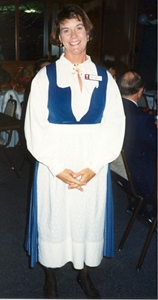
Fox, Joyce

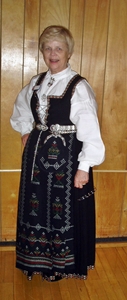
Sunnmøre Bunad from Møre and Romsdal.
This bunad was made for Joyce in Norway. She bought it in 2006 in Nordfjord.
Jensen, Karen

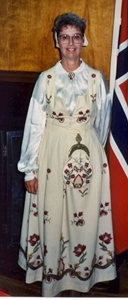
Karen’s bunad is a Gudbrandsdalen bunad made in the 1800s.
Johansen, Peachy

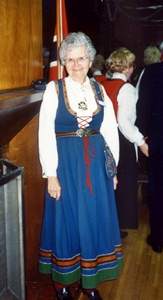
Vestfolddrakt
Light blue was first used, with handwoven trim, green wool border around the bottom, a white linen blouse with special white embroidery.
The embroidery design on purse was taken from a pillow design found on a viking ship - no doubt the Goksta ship found in Sandar, just outside of Sandefjord.
The Drakt was a gift from her parents in May 1935.
Klein, Harriet

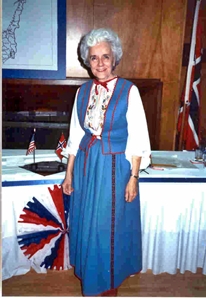
Bunad from Hedmark.
The area of Hedmark includes the town of Hamar.
The entire collection of bunads from Hedmark came as a result of the bunad movement that began in this century. The traditional man´s costume had never been out of use, and it was officially named the Østerdal bunad.
The woman´s bunad for Hedmark was designed in 1935 and re-designed in 1952. It was copied after a painting called Girl from Hedmark made by J.F.L. Drier. Dreier painted folk costume pictures from Hedmark, mostly form Østerdalen.
Larson, Ray - Arlene and Family

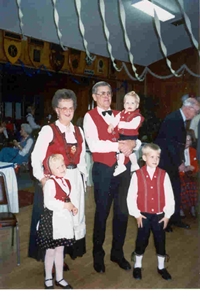
Ray & Arlene Larson with their grandchildren Thea, Lars and Stephen LaBere
Lostegaard, Esther

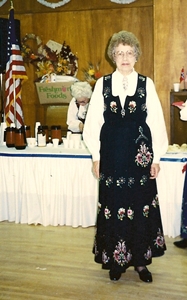
The Gudbrandsdalen bunad was designed in the 1920s. The flower pattern embroidery was copied from an antique skirt with a flower pattern now found at the Norwegian Folk Museum.
Today this bunad can be made in blue, black or white. It can be used with or without an apron. the skirt is made of solid-colored wool material with flower pattern embroidery in a variety of colors. It is loosely pleated. The bodice is made of the same material as the skirt, and it has the same flower pattern embroidery in both back and front. The bodice is short and is attached to the skirt. It has a concealed closing in front. The blouse is made of white linen or cotton cloth, it has tatting on the turn-down collar and cuffs of the sleeves. The apron is made of the same material as the skirt, and it has the same embroidery as the skirt. Black stockings and black shoes with buckles are part of this costume. The silver consists of two brooches and button cufflinks for the blouse. Esther received this bunad as a gift from a relative in Norway when she was visiting there.
Lowell, Muriel & Schwartz, Boyum

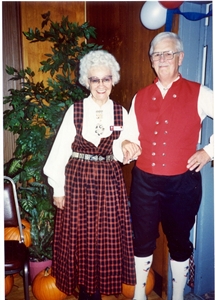
Muriel´s bunad is a Rutebunad or Semelengebunad from Vestre Slidre, where her family is from.
The bunad fabric is homespun in Valdres and made at the Husfliden at Fagerness, Valdres, Norway. There are many Valdres plaids which these Semelengebunads are made from; this one is black, red and a little green woven plaid.
The front of the skirt has 10 small pleats, with 3 rows of hand-sewn pin-tuck pleats, around the rest of the skirt waist, sewn with heavy thread. A sewn-on belt is above the front 10 pleats in front of the bunad.
The hand-made silver belt was made by a silversmith in Valdres and is the belt worn with this particular bunad.
The lower portion of the skirt has two deep tucks. The blouse is of loosely woven cotton fabric with the drop sleeve inserted with tiny pin-tucks at the top of the sleeve. The cuffs and collar are either embroidered with colored thread to match the bunad in the Valdres rosemaling embroidery pattern, or "nuppereller" (tiny lace) also can be used, which is on this blouse.
Nayes, Ella

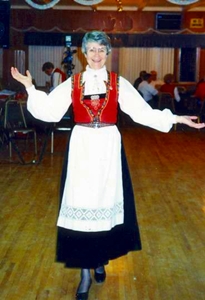
Hardanger bunad made by Ella.
LeRoy´s bunad is the official Sunnfjord bunad for men and was made by his wife Lillian. Lillian copied it from a cousin in her home area in 1979 when they were there. She bought the materials for her bunad and LeRoy´s at that time.
Nelson, Annika

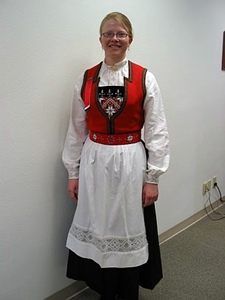
Hardanger bunad.
Sig Peterson in his bunad at the 17th of May 2001 Party. This is a Hardanger bunad that Sig wore so often performing for various groups that it nearly wore out.
He bought this bunad in Norway on one of his many trips abroad.
Schultz, Flo

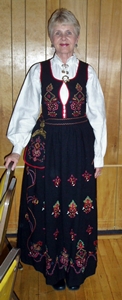
Schultz, Lyle

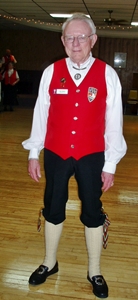
Sheflo, Jelmer & Astrid

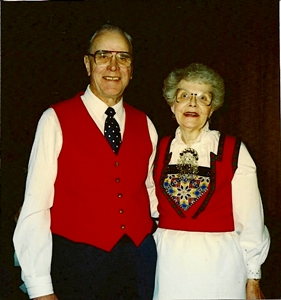
Hardanger Bunader.
Solheim, Audrey

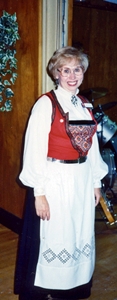
Hardanger Bunad - the Hardanber bunad is the most famous of all the Norwegian folk costumes. during the last part of the 19th century it became a national costume, and it was copied all over the country. The skirt is made of balck wool material. It has a red bodice made of wool with a rose patterned trim. The docie is open in front with a loose insert known as a breastplate. Audrey embroidered her own breastplate, and the entire bunad was made in Bismarck by her friends and family.
The blouse is made of white cloth nad has Hardanger embroiderly around the collar and on the placket. The apron used for formal occasions is made of white cloth with Hardanger embroidery. Black stockings and shoes are part of the costume.
Sverdrup Ladies

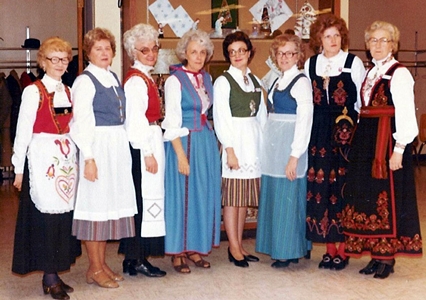
This photo was taken at a Lutefisk Supper many years ago.
Marion Neibauer, Thelma Peterson, Muriel Boyum, Harriet Klein, June Sakshaug, Doris Helgeson, Carolyn Halterman, Helen Storlie
Steinke, Bernice

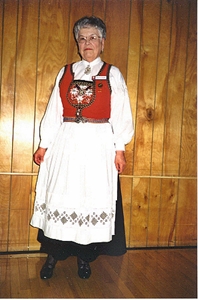
Hardanger Bunad - Bernice inherited this bunad.
Storlie, Gilman & Helen

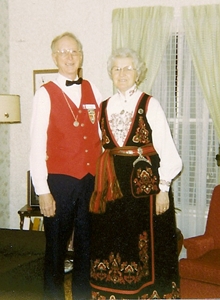
Helen Storlie made her bunad, it is typical of the East Telemark area of Norway. The skirt is made of double shuttle weave wool material with red, blue and green borders around the hem. It is pleated and has a concealed pocket on one side. The bodice is made of red frieze material with rose embroidery on the front parts and in back. It has black rose pattern embroidered edges.
The blouse is made of white linen with embroidery around the collar and cuffs of the sleeves and in front.
Helen is pictured with her husband Gilman Storlie.
Svanes, Ella

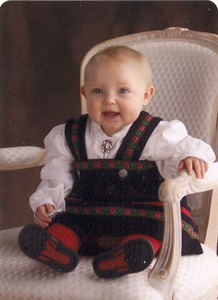
Thiede, Ted & Addie

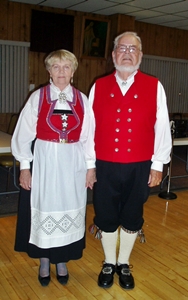
Tyson, Lorna & Ostroot, Lorraine

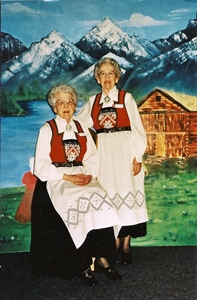
Hardanger Bunads worn by the twins
Watson, Sylvia

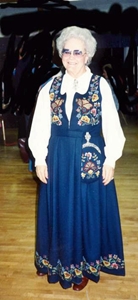
Gudbrandsdalen Bunad
Sylvia and her daughter Linda made this bunad.
This costume was designed in the 1920s. The skirt is made of solid-colored wool material with flower pattern embroidery in a variety of colors. It is loosely pleated. The bodice is made of the same material as the skirt and it has the same flower pattern embroidery in both back and front. The bodice is short and is attached to the skirt. It has a concealed closing in front. The blouse is made of white linen or cotton cloth, it has tatting on the turn-down collar and cuffs of the sleeves. The apron is made of the same material as the skirt, and it has the same embroidery at the skirt´s border embroidery. The bunad can be used with or without an apron. The hat is made of the same material as the rest of the costume. It has embroidery both in front and in back. Black stockings and black shoes with buckles are part of the costume. The silver consists of two brooches and button cufflinks for the blouse.
|